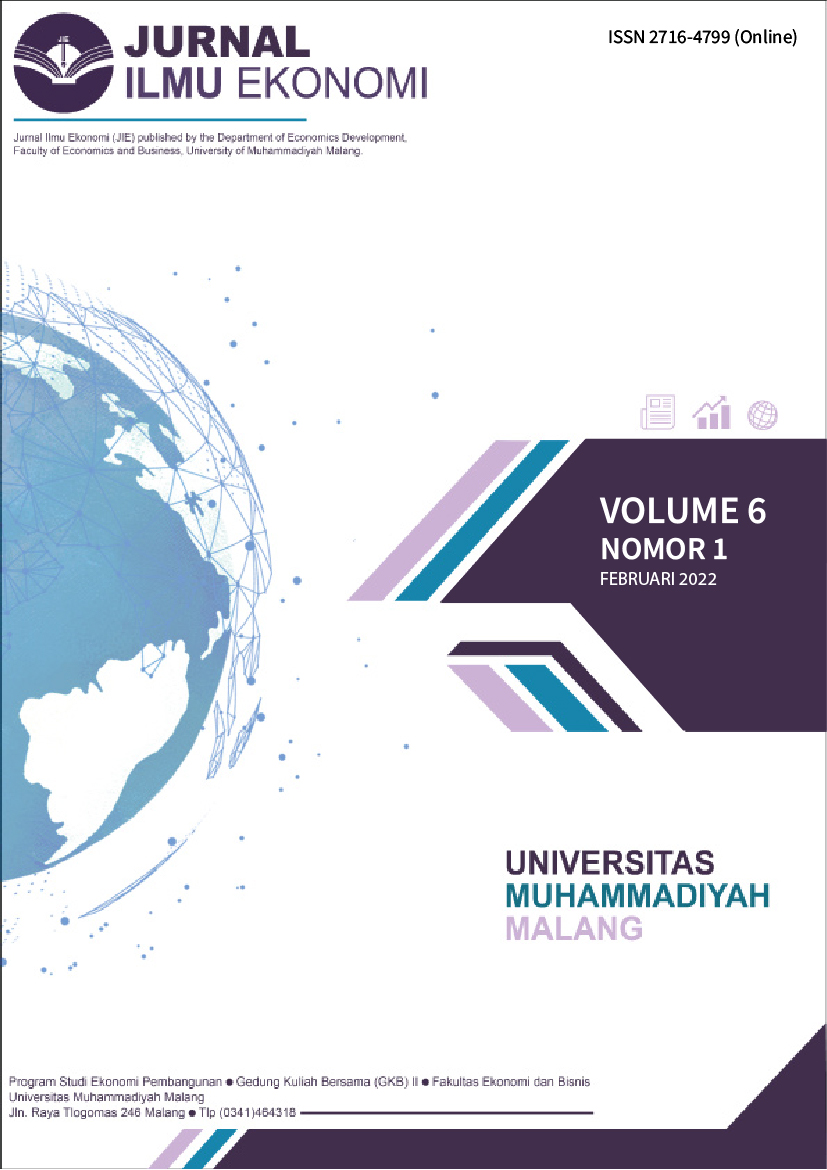Analisis Faktor-Faktor Yang Mempengaruhi Indeks Pembangunan Manusia Di Wilayah Gerbangkertosusila Plus Periode Tahun 2016-2020
DOI:
https://doi.org/10.22219/jie.v6i1.19815Abstract
This study aims to determine the factors that influence the human development index in the Gerbangkertosusila Plus area of East Java Province. This study uses a quantitative descriptive method and the variables used in this study are economies, population, poverty, and special allocation funds in the gate area of kertosusila plus. The data used in this study were obtained from BPS East Java Province. The results of this study indicate that the per capita GRDP has a positive effect, population density has a negative effect, the number of poor people has a negative effect, the special allocation fund for education has a positive effect and the special allocation fund for health has a negative effect on the human development index in the Gerbangkertosusila Plus area.
Downloads
References
UNDP. 2004. Indonesia, Indeks Pembangunan Manusia. http://www.undp.or.id/archives/
Bhakti, Nadia Ayu. (2012). Analisis Faktor- faktor yang Mempengaruhi Indeks Pembangunan Manusia di Indonesia periode 2008-2012. Jurnal Ekonomi dan Keuangan.
Badan Pusat Statistik (2020):Indeks Pembangunan Manusia, Provinsi Jawa Timur
Ginting, S. C. K., Lubis, I., & Mahalli, K. (2008). Pembangunan Manusia di Indonesia dan Faktorfaktor yang Mempengaruhinya. WAHANA HIJAU Jurnal Perencanaan & Pengembangan Wilayah.
Sadono, Sukirno. 2010. Makroekonomi. Teori Pengantar. Edisi Ketiga. PT. Raja Grasindo Perseda. Jakarta.
Todaro,M. 2006. Pengembangan Ekonomi Dunia Ketiga. Edisi Kedelapan. Jakarta: Penerbit Erlangga.
Pratowo, N. I. (2011). Analisis Faktor-Faktor yang Berpengaruh terhadap Indeks Pembangunan Manusia. Jurnal Studi Ekonomi Indonesia.
NURFADHLI, RIZKI.(2017) ANALISIS FAKTOR-FAKTOR YANG MEMPENGARUHI INDEKS PEMBANGUNAN MANUSIA DI PULAU SUMATERA PERIODE TAHUN 2010-2015. Skripsi thesis, UIN Sunan Kalijaga.
Latuconsina ,Zulfikar Mohamad Yamin. (2017) Analisis Faktor-faktor yang Mempengaruhi Indeks Pembangunan Manusia Kabupaten Malang Berbasis Pendekatan Perwilayahan dan Regresi Panel. Jurnal ekonomi.
Astri, Meylina dkk (2013) Pengaruh Pengeluaran Pemerintah Daerah pada Sektor Pendidikan dan Kesehatan terhadap Indeks Pembangunan Manusia di Indonesia. Jurnal FEB, UNJ
Mahulete, Ummi K. (2016). Pengaruh DAU dan PAD terhadap Belanja Modal di Kabupaten/Kota Provinsi Maluku. Skripsi. Universitas Muhammadiyah Malang.
Todaro, Michael P. dan Stephen C. Smith. 2006. Pembangunan Ekonomi (edisi kesembilan, jilid I). Jakarta : Erlangga
Republik Indonesia, Undang-undang SISDIKNAS no. 20 tahun 2003
Ghozali, Imam. 2018. “Aplikasi Analisis Multivariate Dengan Program IBM SPSS”. Semarang: Badan Penerbit Universitas Diponegoro.
Republik Indonesia, Undang-Undang No. 36 tahun 2009
Republik Indonesia, Undang-Undang No.20 tahun 2003
Ratal Wirjasantosa. (1984). Olahraga – Studi Pembelajaran. Jakarta: UI-press.
Sukirno, Sadono. 2013. ―Makroekonomi Teori Pengantar Edisi Ketiga.
Ranis and Stewart. (2000). Economic Growth and Human Development. Jurnal World Development.
Kumalasari, M. (2011). Analisis Pertumbuhan Ekonomi, Angka Harapan Hidup, Angka Melek Huruf, Rata-Rata Lama Sekolah, Pengeluaran Perkapita dan Jumlah Penduduk Terhadap Tungkat Kemiskinan di Jawa Tengah. Semarang: Skripsi (S1). Fakultas Ekonomika dan Bisnis, Universitas Diponegoro.
Badan Perencanaan Pembangunan Daerah.2011. Pengertian Kemiskinan.
Sarwono, SarlitoW. 1992. Psikologi Lingkungan. Jakarta: Gramedia
Todaro, M. P. (2004). Pembangunan Ekonomi di Dunia Ketiga, Jilid 1, (Edisi 8). Jakarta: Erlangga.
Mirza, D. S. (2015). Pengaruh Kemiskinan, Pertumbuhan Ekonomi, dan Belanja Modal terhadap Indeks Pembangunan Manusia Di Jawa Tengah.
Kharisma, Virgie Delawillia.dkk (2019) ANALISIS DAMPAK KEBIJAKAN ALOKASI DANA OTONOMI KHUSUS BIDANG PENDIDIKAN DAN KESEHATAN TERHADAP INDEKS PEMBANGUNAN MANUSIA DI PROVINSI PAPUA.
Downloads
Published
How to Cite
Issue
Section
License
Copyright (c) 2022 Pangestu, R. A.

This work is licensed under a Creative Commons Attribution-ShareAlike 4.0 International License.
Authors who publish with this journal agree to the following terms:
- For all articles published in the JIE (Jurnal Ilmu Ekonomi), copyright is retained by the authors. Authors give permission to the publisher to announce the work with conditions. When the manuscript is accepted for publication, the authors agree to the automatic transfer of non-exclusive publishing rights to the publisher.
- Authors retain copyright and grant the journal right of first publication with the work simultaneously licensed under a Creative Commons Attribution-NonCommercial-ShareAlike 4.0 International License that allows others to share the work with an acknowledgement of the work's authorship and initial publication in this journal.
- Authors are able to enter into separate, additional contractual arrangements for the non-exclusive distribution of the journal's published version of the work (e.g., post it to an institutional repository or publish it in a book), with an acknowledgement of its initial publication in this journal.
- Authors are permitted and encouraged to post their work online (e.g., in institutional repositories or on their website) prior to and during the submission process, as it can lead to productive exchanges, as well as earlier and greater citation of published work (See The Effect of Open Access).
This is an open access article and licensed under a Creative Commons Attribution-NonCommercial-ShareAlike 4.0 International License








